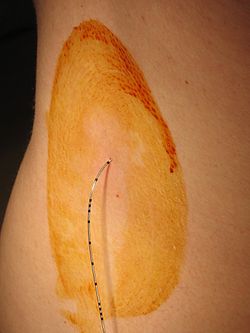
Iodine tincture

Tincture of iodine, iodine tincture, or weak iodine solution is an antiseptic. It is usually 2–7% elemental iodine, along with potassium iodide or sodium iodide, dissolved in a mixture of ethanol and water. Tincture solutions are characterized by the presence of alcohol. It was used from 1908 in pre-operative skin preparation by surgeon Antonio Grossich. Tincture of iodine, iodine tincture, or weak iodine solution is an antiseptic. It is usually 2–7% elemental iodine, along with potassium iodide or sodium iodide, dissolved in a mixture of ethanol and water. Tincture solutions are characterized by the presence of alcohol. It was used from 1908 in pre-operative skin preparation by surgeon Antonio Grossich. In the United Kingdom the development of an iodine solution for skin sterilisation was pioneered by Lionel Stretton. The British Medical Journal published the detail of his work at Kidderminster Infirmary in 1909. Stretton used a much weaker solution than that used by Grossich. He claimed in 1915 that Grossich had been using a liquid akin to Liquor Iodi Fortis, and that it was he, Stretton, who had introduced the method using Tincture of Iodine BP which came to be used across the world. USP Tincture of Iodine is defined in the U.S. National Formulary (NF) as containing in each 100 mL, 1.8 to 2.2 grams of elemental iodine, and 2.1 to 2.6 grams of sodium iodide. Alcohol is 50 mL and the balance is purified water. This '2% free iodine' solution provides about one mg of free iodine per drop ('2% free iodine' is based on the quantity of elemental iodine, not sodium/potassium iodide; 1.8-2.2 grams I2 in 100 ml water corresponds to 0.070919-0.086679 M I2 ). USP Strong Iodine Tincture is defined in the NF as containing in each 100 mL, 6.8 to 7.5 gram of iodine, and 4.7 to 5.5 gram of potassium iodide. Purified water is 50 mL and the balance is alcohol. This 7% tincture solution is about 3.5 times more concentrated than USP 2% tincture. As in the case of Lugol's iodine, the role of iodide in the solution is to increase the solubility of the elemental iodine, by turning it to the soluble triiodide anion I3−. However, since iodine has moderate solubility in ethanol, it is also assisted by this solvent directly. Lugol's iodine, by contrast, has no alcohol, and has twice the mass of potassium iodide as of elemental iodine. Alcohol content in the tincture of iodine can be determined by the methods of Alcock, Roscoe - Schorlemmer and Thurston - Thurston. As both USP solutions contain elemental iodine, which is moderately toxic when ingested in amounts larger than those required to disinfect water, tincture of iodine is sold labelled “for external use only,” and used primarily as a disinfectant. Tincture of iodine is often found in emergency survival kits, used both to disinfect wounds and to sanitize surface water for drinking. When an alcohol solution is not desirable for this purpose, the alcohol-free Lugol's iodine, an aqueous solution of iodine in potassium iodide solution, or else povidone-iodine (brand names Wokadine, Betadine), a PVPI solution, can be used. Small amounts may be added to suspect drinking water as a disinfectant (typically 5 mg free iodine per liter, or 5 drops of 2% tincture). Though this treatment is effective against bacteria and virus, it does not protect against protozoan parasites such as Cryptosporidium and Giardia. Iodine solution is used to sanitize the surface of fruit and vegetables for bacteria and virus. The common concentration for sanitization is 25 ppm idophor for 1 minute. However, the effectiveness depends on whether the solution penetrates into rifts, and whether dirt is effectively removed at first. But, oocytes of protozoan parasites will not be killed, and it is also doubtful that bacterial spores are killed. Iodine solutions should not be considered able to sanitize or disinfect salad, fruit or vegetables that are contaminated by feces. Thus, it should not be considered safe to eat raw fruit, salads and vegetables which are sanitized with iodine, if they could be contaminated by feces.
